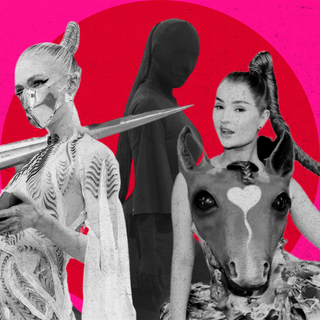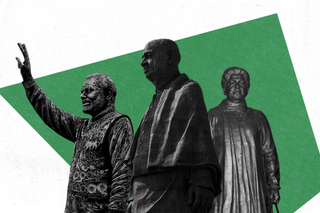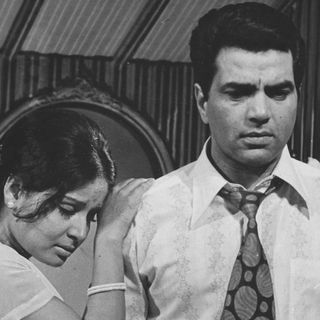
What Explains Societal Obsession With Erecting Statues in a Post‑Truth World?
When our reality, values, and knowledge keep changing, it makes little sense to have a symbol of permanence installed on a physical pedestal.

Percy Bysshe Shelley’s legacy has outlasted empires. His “Ozymandias,” a sonnet about pharaoh Rameses II, drips off the tip of the tongue: “Look on my Works, ye Mighty, and despair!” The claim of grandeur is juxtaposed with the “colossal wreck” in the lone sand. The humbling indictment suggests statues, as an act of memorializing and adulating rulers will fall in the expanse of time.
Yet, the statue has endured in cultural legacy. Recently, the government announced a 14-feet-tall statue of Prime Minister Narendra Modi will soon be unveiled for the civic eye in Bengaluru. India’s “Statue of Unity,” depicting Sardar Vallabhbhai Patel, positions itself as the world’s tallest creation. In 2018, a proposed Shivaji Maharaj memorial of the 17th-century warrior king, costing Rs. 2,800 crores proved to be divisive.
The cost-benefit analysis of public statues is widely debated. The ethical reasons for investing crores in statues aside, what does it mean to have a statue towering over people today? Collective memory is short-lived. Reality is fickle. Emotions and personal beliefs overpower truth, leaving little consensus about what constitutes the present, let alone the past.
Experts also note any monumental art such as statues is an important symbol of a culture’s history; maintaining these symbols becomes an activity in preserving cultural memory. The Statue of Unity, for instance, is a salute to India’s independence movement. The demand to erect a statue for Shivaji Maharaj off the coast of Mumbai is an ode to his contribution to nation-building. The proposed Ram statue planned for the city of Ayodhya, a site of communal conflict, seeks to “establish Ayodhya’s identity.”
The fixation also suggests the ability of statues to evoke emotions and create a cultural narrative. A statue of Lord Curzon, a former viceroy of India, in Kolkata was replaced by one of Sri Aurobindo. It was an effort to replace colonial symbols with local ones. Even later, Mayawati, the former Chief Minister of Uttar Pradesh, inaugurated statues and monuments. The Shivaji Maharaj statue is quickly gaining credence as a symbol of Hindu resistance against seeming Muslim autocracy, Debika Ray noted in Apollo magazine. Rulers and leaders find the cement and its extravagance but minor costs to pay for this act of historical preservation.
Like renaming cities, streets, and chowks, statues are potent symbols of an individual and national identity.
The cultural obsession with erecting statues is at least 40,000 years old. “From their earliest inception, statues were less about the individuals they depict than about how we see ourselves,” Kelly Grovier, American poet and critic, noted in the BBC.
This raises two questions. “We” is not a homogenous entity in a fragmented country. The question of who the statue is made for hangs heavy in the air. People relate with leaders, politicians, influential citizens for their desire to see an aspect of themselves echo in the image of another person. No statue today can claim to sufficiently reflect the ideologies of a fragmented nation. After a point, these large figures distort histories and versions of the truth. The proposed Ram statue in Ayodhya is but one example.
Erecting statues of “glorious” people who do “glorious” things suffers from one fatal fallacy: one person’s idea of glory is another person’s lived reality of suppression. That’s why the Black Lives Movement protests last year, after the murder of George Floyd, ferociously demanded the removal of statues that glorify oppressive figures. “Such an impulse may explain why it is so agonizingly difficult to tolerate the persistence of memorials that venerate past masters of pain. The outrage that many feel about having to share the streets with such hulking ghosts of oppression is deep and crushingly real,” Grovier said.
Secondly, statues have always signaled a sense of indulgence in building one’s self-image. Ozymandias, the mighty Egyptian ruler, is embedded in memory. “This statue obsession mistakes adulation for history, history for heritage, and heritage for memory,” journalist Gary Younge noted in The Guardian. The cultural prominence of statues distorts history, in a way, by positioning the “mighty man” myth at the center. “Individuals play an important role in history. But they don’t make history by themselves… For when you put up a statue to honor a historical moment, you reduce that moment to a single person,” Younge points out. The cost? A society collectively sidelines the contributions of those already marginalized, tampering with the credibility of any moment in time.
Statues, then, do not just fail to teach us about the past or give a misleading idea about particular people or particular historical events – they also skew how we understand history itself. It is not just a harmless obsession with big things. It is the veritable creation of history. Memorialization and art are no longer restricted to upholding political legacy; they question fact and memory’s credibility in a post-truth reality.
The relevance of statue culture is not limited to history itself. A society’s fixation with statues shows the desire to erect a permanent statement of fact, culture, and truth that people can never question. The irony is evident; the impermanence of life, value systems, and ideologies can never fit a concrete mold. Tearing down statues during the BLM protest, for instance, “denies the narrative or values of those who erected the monument, and makes a statement about our values in the present,” Mohamed Chtatou of the University of Mohammed V in Morocco noted.
Related on The Swaddle:
Plus, this is a different world; the threshold for knowledge and facts is lower, information dissemination happens at lightspeed. The social media dome of existence also validates the larger-than-life personalities of leaders and cultural figures. The statue is a cultural product of hero-worshipping and uncritical veneration. It is accompanied by naming stadiums after leaders or a country’s space agency bearing a politician’s photo. This glorification tends to carve a “cult of personality.”
In this post-truth reality, there’s no one truth, no one culture, no one fact people can agree on. To take but one example: Politicians of the ruling party claim that India’s handling of Covid19 was “successful.” The same is easily discounted. Lived experiences of people who lost their loved ones or those who struggled to lay hands on something as ubiquitous as oxygen paint a different picture.
This makes the ambitious project of erecting statues futile. When our reality, values, and knowledge keep changing, it makes little sense to have a symbol of permanence installed at an ideological and physical pedestal. Unlike Ozymandias, time will do little to erase the cultural legacy of statues, for it is not limited to physical constructs. The social media and cultural forces in place will allow the legacy of these statues to permeate memory and every aspect of our being, giving it a lifeline stronger than ever. The statue may fall, but the ideological ground it was constructed on is harder to tackle in a post-truth world — there is disagreement about the most banal of things.
The motive behind resisting the erection of any statue thus strikes out with clarity. Some may topple large figures, and others may fight for relocation. Some, like Shelley, may point out the irony of memorialization some centuries later, cautioning the world about hubris and impermanence. There may be a traveler from an antique land too.
The most critical resistance has to come from a visceral understanding of art, aesthetics, and legacy. What made “Ozymandias” powerful was its ability to mock the aspirations of the ruler, to introspect and foretell at once the transience of any empire. Could Shelley have ever anticipated the enduring legacy of statues in people’s memories? Maybe, maybe not.
Saumya Kalia is an Associate Editor at The Swaddle. Her journalism and writing explore issues of social justice, digital sub-cultures, media ecosystem, literature, and memory as they cut across socio-cultural periods. You can reach her at @Saumya_Kalia.
Related


What Do Indian Biopics Tell Us About Our Culture Today?
